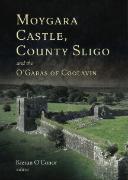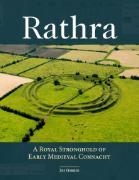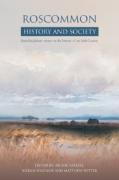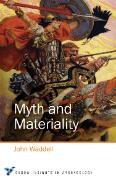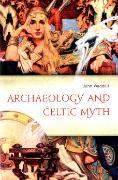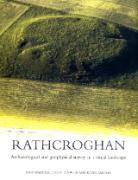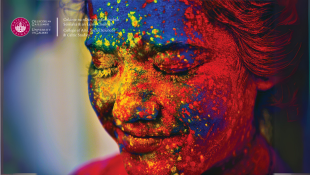-
Courses

Courses
Choosing a course is one of the most important decisions you'll ever make! View our courses and see what our students and lecturers have to say about the courses you are interested in at the links below.
-
University Life

University Life
Each year more than 4,000 choose University of Galway as their University of choice. Find out what life at University of Galway is all about here.
-
About University of Galway

About University of Galway
Since 1845, University of Galway has been sharing the highest quality teaching and research with Ireland and the world. Find out what makes our University so special – from our distinguished history to the latest news and campus developments.
-
Colleges & Schools

Colleges & Schools
University of Galway has earned international recognition as a research-led university with a commitment to top quality teaching across a range of key areas of expertise.
-
Research & Innovation

Research & Innovation
University of Galway’s vibrant research community take on some of the most pressing challenges of our times.
-
Business & Industry

Guiding Breakthrough Research at University of Galway
We explore and facilitate commercial opportunities for the research community at University of Galway, as well as facilitating industry partnership.
-
Alumni & Friends

Alumni & Friends
There are 128,000 University of Galway alumni worldwide. Stay connected to your alumni community! Join our social networks and update your details online.
-
Community Engagement

Community Engagement
At University of Galway, we believe that the best learning takes place when you apply what you learn in a real world context. That's why many of our courses include work placements or community projects.
Exploring the Medieval Literature and Related Archaeology of Connacht
Archaeological and Literary Landscapes
The province of Connacht has a uniquely rich literary tradition for ancient, medieval and early modern times, and uniquely well-preserved archaeological landscapes which are often the focus of that literary tradition. Most of the surviving 'Great Books of Ireland' were produced by Connacht scribes or for Connacht patrons, including the Book of the Dun Cow, the Book of Uí Maine, the Book of Lecan, the Yellow Book of Lecan, the Book of Ballymote, to name just the better-known codices. Whatever about the origins of Ireland's Heroic Cycle and Ossianic (Fenian) Cycle, the outstanding works of each cycle, Táin Bó Cúailnge (The Cattle Raid of Cooley) and Acallam na Senórach (The Colloquy of the Ancients), owe their extant form to the input of Connacht writers.
Eminent learned families working for centuries in Connacht left a vast quantity of historical, legal and legendary material, much of which has yet to be adequately researched and fully appreciated. Among them are the familes of Mac Aodhagáin, Ó Maoil Chonaire, Mac Fhir Bhisigh, Ó Dubhagáin, Ó Duibhgeannáin, Ó Gadhra and Ó hUiginn. To members of these and other Connacht-based learned families we are indebted for much of the extant corpus of Gaelic legal texts, for annalistic collections such as the Annals of Connacht, the Annals of Loch Cé, and the Annals of the Four Masters, for genealogical materials such as Dubhaltach Mac Fhir Bhisigh's outstandingly important collection, Leabhar Mór na nGenelach, for hagiographical materials concerning the saints of Connacht such as Commán, Fursa, Brendan, Grellán, Iarlaith, Énnae, Cáelainn, Dar Í, Athracht, Cráebnat, Súarnat and others (as well as saints elsewhere), and for a vast body of traditional lore in prose, and of bardic and later poetry. The aim in exploring these very extensive written materials in tandem with the on-going exploration of archaeological monuments, sites and landscapes is to integrate the knowledge and practices of different disciplines and to achieve a much fuller understanding of all aspects of cultural production.
The archaeological component of this project addresses a number of sites and monuments where myth, history, literature and archaeology converge. These include the continuing study of elements of the archaeology of the royal site of Crúachain (Rathcroghan), Co. Roscommon, where the Táin Bó Cuailgne began, and the archaeology of Cloonfree, ringfort and mound at Rathbrennan, near Roscommon, where according to Acallam na Senórach, Patrick, met the warrior Caílte and the king of Connacht, and a moated site near Strokestown, celebrated as a royal settlement of the early 14th century in Bardic poetry.
Continuing field research in Rathcroghan’s royal landscape
The work of the ArchaeoGeophysical Imaging was concluded in 2009 with the publication of Rathcroghan: archaeological and geophysical survey in a ritual landscape (Waddell, Fenwick & Barton, 2009) but archaeological field investigation and publication has continued over the intervening years in collaboration with colleagues in other Disciplines, Schools and Colleges at the University of Galway (see below).
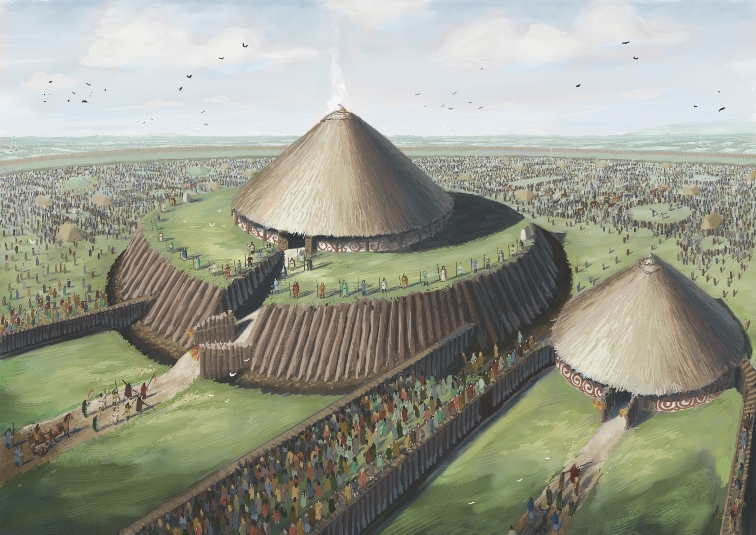 |
| A conjectural reconstruction of Rathcroghan Mound, by J.G. O’Donoghue (Archaeological Illustrator) in collaboration with Joe Fenwick (Archaeological Field Officer, NUI Galway), as it might have looked during the Later Iron Age, some 2000 years ago. This visualisation is based on an interpretation of the archaeological and geophysical surveys undertaken by the ArchaeoGeophysical Imaging Project and the School of Geography and Archaeology, NUI Galway (©J.G. O’Donoghue / Roscommon County Council 2015). |
The surroundings of Rathcroghan Mound, the great ceremonial earthworks known as the Mucklaghs, the cave site of Oweynagat and the unusual multivallate site of Cashelmanannan were geophysically investigated between 2010 and 2012 (Professor John Waddell, Dr Roseanne Schot, Dr Gerard Dowling & Joe Fenwick) to see if there are traces of other archaeological monuments or features in the immediate vicinity of these enigmatic monuments and the results have been published in Emania, Vol. 23 (see below: Schot, Waddell & Fenwick 2016).
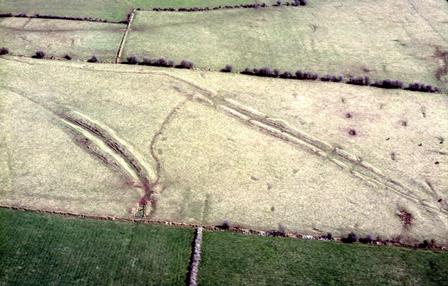 |
According to legend, the Mucklaghs in Rathcroghan were named because they were believed to be the result of the rootings of a magical boar. This monument consist of two very large curving parallel earthwork banks, the northern of which is 100m long and its southern less southern equivalent some 285m long. |
More recently, two Geophysical Field Schools, part of a collaborative initiative between Archaeology, School of Geography and Archaeology, and Earth and Ocean Sciences, School of Natural Sciences, NUI Galway, were conducted on and around Rathcroghan Mound during the summers of 2013 and 2014 (Dr Eve Daly, Shane Rooney & Joe Fenwick) and an extensive and detailed aerial photographic survey was undertaken over several square kilometres of the core archaeological complex as part of independent research undertaken by the Rathcroghan Field Systems Project in 2017/18 (Gary Dempsey & Dr Paul Naessens).
The conjoined ringforts of Rathbrennan
Rathbrennan consists of a pair of imposing conjoined ringforts near the summit of a hill just east of Roscommon town and has a circular mound in the interior and near the rampart of the easternmost example. It is the subject of a programme of detailed topographical survey. A preliminary plan clearly shows the location of the mound near the rampart and the puzzling fore-works that mark the entrance to this monument (Professor John Waddell and Joseph Fenwick).
|
Computer-generated topographical map of Rathbrennan conjoined earthworks, Co. Roscommon. |
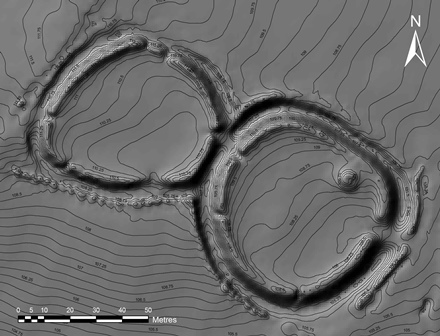 |
|
The mound in the fort of Rathbrennan where Patrick is said to have met the king of Connacht and Cailte, the nephew of Fionn mac Cumaill. |
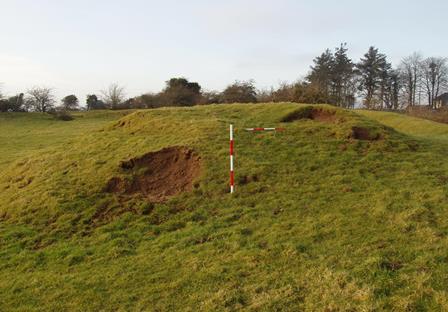 |
The moated site of Cloonfree
The royal settlement at Cloonfree is the subject of several Bardic praise-poems. It is a medium-sized moated site built for Hugh O’Conor, king of Connacht, as a royal residence around the year 1300. Analysis of the bardic poems suggests that a large post-and-wattle feasting hall existed within this defended enclosure. The remains of this ‘shapely fort with burnished doors’ have been surveyed by the Discovery Programme (Kieran O’Conor and Tom Finan).
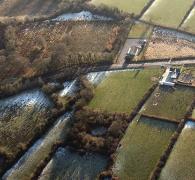 |
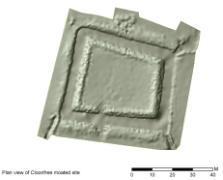 |
| The moated site at Cloonfree near Strokestown is heavily obscured by trees today. |
Computer-generated topographical modelof Cloonfree moated site. |
Publications linked to ‘Exploring the Medieval Literature and Related Archaeology of Connacht’
(Published Books)
O’Conor, K. (ed) 2023
|
Fenwick, J. 2021 Rathra: |
Farrell, R., O’Conor, K. |
|
Waddell, J. 2018 |
Waddell, J. 2014 |
Waddell, J., Fenwick, J. |
Finan, T. and O'Conor, K. 2002, The moated site at Cloonfree, Co. Roscommon, Journal of the Galway Archaeological and Historical Society 54, 72-87.
Waddell, J., Fenwick, J. & Barton, K. 2009, Rathcroghan Co. Roscommon: Archaeological and Geophysical Survey in a Ritual Landscape. 249 pp. Wordwell, Dublin.
Waddell, J. 2011, Continuity, cult and contest. In R. Schot, C. Newman and E. Bhreathnach (eds), Landscapes of Cult and Kingship, Four Courts Press, Dublin, 192-212. A proof copy of this article is available on-line through the National University of Ireland Galway's library web site (in ARAN).
Waddell, J. 2014, The cave of Crúachain and the Otherworld. In J. Borsje, A. Dooley, S. Mac Mathúna and G. Toner (eds), Celtic Cosmology and the Otherworld, 77-92. Pontifical Institute of Medieval Studies, Toronto 2014. A proof copy of this article is available on-line through the National University of Ireland Galway's library web site (in ARAN).
Waddell, J. 2014, Archaeology and Celtic Myth. 203pp. Four Courts Press, Dublin.
Schot, R., Waddell, J. & Fenwick, J. 2016, Geophysical survey at Rathcroghan 2010-2012, Emania 23, 51-59.
Fenwick, J. 2018, The Late Prehistoric ‘royal site’ of Rathcroghan, Co. Roscommon; an enduring paradigm of enclosed sacred space. Emania 24, 35-51.
Waddell, J. 2018, Myth and Materiality. Oxbow Press, Oxford.
Fenwick, J.P. 2018, A comparative archaeological review of the late prehistoric ‘royal site’ of Rathcroghan. In R. Farrell, K. O’Conor & M. Potter (eds), Roscommon History and Society: Interdisciplinary essays on the history of an Irish County. Geography Publications, Dublin. 63-86.
Jones, C. 2018, Between north and south, east and west. Chalcolithic and Early Bronze Age connections and transitions in County Roscommon. In R. Farrell, K. O’Conor & M. Potter (eds), Roscommon History and Society: Interdisciplinary essays on the history of an Irish County. Geography Publications, Dublin. 19-34.
O’Conor, K. & Finan, T. 2018, Medieval settlement in north Roscommon, c. 1200AD – c. 1350AD. In R. Farrell, K. O’Conor & M. Potter (eds), Roscommon History and Society: Interdisciplinary essays on the history of an Irish County. Geography Publications, Dublin. 105-132.
Waddell, J. 2018, Roscommon in later prehistory – a land of kings and heroes? In R. Farrell, K. O’Conor & M. Potter (eds), Roscommon History and Society: Interdisciplinary essays on the history of an Irish County. Geography Publications, Dublin. 35-62.
Farrell, R., O’Conor, K. & Potter, M. (eds). 2018, Roscommon History and Society: Interdisciplinary essays on the history of an Irish County. Geography Publications, Dublin.
Fenwick, J., Daly, E. & Rooney, S. 2020 Rathcroghan revisied: a renewed archaeological and geophysical exploration of selected areas of the core ritual complex. Emania 25. 81-97.
Fenwick, J., Daly, E. & Rooney, S. 2020 Under the radar at Rathcroghan. Archaeology Ireland 34(4). 48-52.
Ní Dhonnchadha, M. 2020 Old Names for the River Suck and Associated Sites. Celtica 32, 101-112.
Ní Dhonnchadha, M. 2020 Síd Crúachan and its Names. Celtica 32, 113-126.
Fenwick, J. 2021 Rathra: a royal stronghold of early medieval Connacht. pp112, Roscommon.
(available from: https://www.rathcroghan.ie/shop/)
Fenwick, J. 2022 Stranger things at Castlestrange. Archaeology Ireland 36(3), 30-35.
O'Conor, K. (ed) 2023 Moygara Castle, county Sligo, and the O’Garas of Coolavin. Four Courts Press, Dublin.








